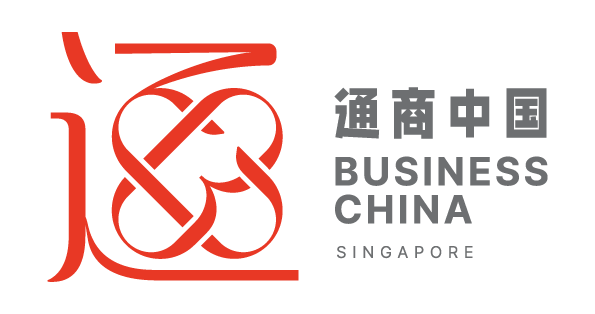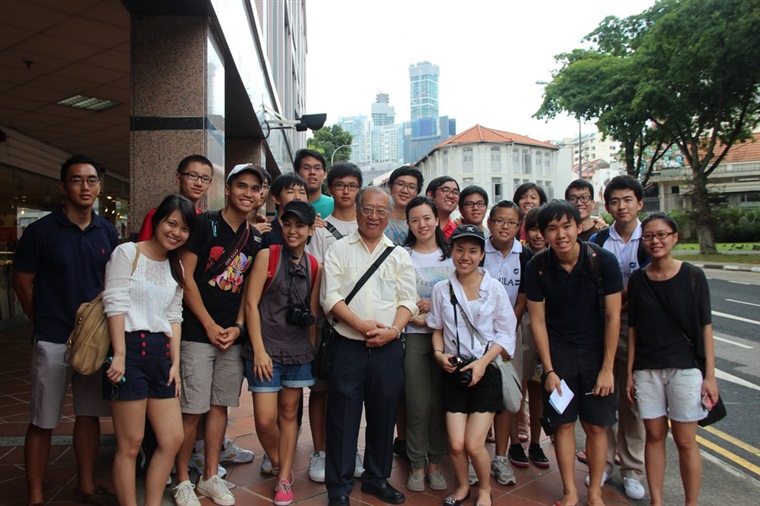On 16 March 2013, twenty-four Business China Youth Chapter Members (BCYC), including three Business China interns from Jurong Junior College, embarked on a heritage tour around Chinatown. Guided by veteran journalist and cultural researcher Mr Han Tan Juan, the tour led the youths to explore the rich history and local cultural heritage of famous landmarks in Chinatown. Prominent places visited included: The Majestic, Great Southern Hotel (currently Yue Hwa Building), Upper Cross Street, Pagoda Street, Smith Street and Kreta Ayer Street. With more than 30 years’ experience in the media industry, Mr Han shared with the youths the significance of these various sites in the course of Singapore’s history.
Participants started the tour at The Majestic on Eu Tong Sen Street. This majestic building with an eclectic style used to be a Cantonese opera house not originally owned but later bought over by Eu Tong Sen, one of Singapore’s early pioneers. He also acquired the main street and named it after himself. The opera house was later converted into a cinema and several other uses before its current commission. Neighbouring The Majestic is also another of Eu’s properties, the Great Southern Hotel, which was one of Singapore’s hippest locations in the early 20th century. With his financial prowess and vision, Eu Tong Sen engaged a British engineer to design the Great Southern Hotel, making it the first Chinese-owned building to have an elevator in Singapore when it opened in 1927.
The fifth floor of Great Southern Hotel was frequented by cultural and social elites such as Xu Beihong and Yu Dafu from China, during the pre-war era. Participants were also amazed by the interesting account of then Editor of Sin Chew newspaper, Yu Dafu, when held a banquet in the hotel to ‘celebrate’ his divorce with his wife! Even the youths considered his actions avant-garde.
Participants then moved on to Upper Cross Street, where the ‘Sook Ching massacre’ of World War II took place in 1942. They learnt about the cruel facts of the massacre and saw pictures of how men were being tortured.
Mr Han then brought the group to Pagoda Street, where coolie lodging houses congregated more a century ago. He told moving stories of harsh living and working conditions and showed the exact location of one of the biggest original coolie agencies at No. 37 Pagoda Street.
At Smith Street, also known as Theatre Street, participants visited the Lai Chun Yuen Opera House, a traditional architecture with more than a century of history. Core members of the Chinese United League, including Sun Yat Sen, Hu Hanmin and Wang Jingwei had delivered public speeches during intermissions of Cantonese operas, calling for support to overthrow the Qing Dynasty.
Moving on to the corner of New Bridge Road and Keong Siak Street, Mr Han related that commoners like him in the older days would gather there to enjoy sessions of classic Chinese tales. The learned story-tellers also double-hatted as ‘newscasters’ when they read the daily headlines to the mostly illiterate audience then. To the participants, Mr Han himself became the storyteller, a living source of information for them to know more about Singapore’s stories and history.
At the final stop along Kreta Ayer Street, Mr Han introduced the origin of Chinatown’s name ‘Niu Che Shui’, which literally means ‘bullock cart water’. It was here that Indians used to transport water using bullock carts to sell to residents in this area. Mr Han further introduced famous early pioneers like Aljunied the Arabia merchant who would have a road named after him and Tan Kim Seng, who donated money to build the MacRitchie Reservoir.
The Chinatown Heritage Tour offered a rare insight to Singapore’s heritage and historical affinities with China and was a truly mind-opening endeavour for the youths.
Organised by Business China for youth chapter members, the Heritage Tour was also in line with the mandate of Business China, that is to nurture an inclusive bilingual and bicultural group of Singaporeans through extensive use of the Chinese language as the medium of communication, so as to sustain our multi-cultural heritage, and to develop a cultural and economic bridge linking the world and China.
Article contributed by: Shirley Leong, Lim Wan Rong & Chen Yuanhao (Jurong Junior College)

